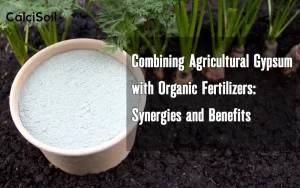
Agricultural gypsum, primarily composed of calcium sulfate dihydrate (CaSO₄·2H₂O), is widely recognized for its role in improving soil health and enhancing crop yields. Its application in wheat cultivation has garnered attention due to its potential benefits in various soil conditions, particularly in saline and sodic soils. This article explores the effects of agricultural gypsum on wheat yields, examining its impact on soil properties, plant growth, and overall agricultural productivity.
Soil Health and Gypsum
Soil Composition and Structure
Gypsum plays a crucial role in modifying soil composition and structure. It enhances soil permeability by promoting better aggregation, which improves water infiltration and root penetration. This is particularly beneficial in soils affected by salinity or sodicity, where traditional amendments may fall short. The application of gypsum can lead to:
Improved Soil Structure: Gypsum helps flocculate clay particles, reducing compaction and enhancing aeration.
Increased Water Infiltration: Better soil structure allows for improved water movement through the soil profile, which is vital for crop growth.
Reduction of Soil Salinity: Gypsum can displace sodium ions in sodic soils, lowering the exchangeable sodium percentage (ESP) and improving overall soil health.
Chemical Modifications
The chemical modifications resulting from gypsum application include increased availability of essential nutrients such as calcium (Ca) and sulfur (S). These nutrients are vital for wheat growth:
Calcium Availability: Calcium is essential for cell wall structure and stability, influencing root development and overall plant vigor.
Sulfur Availability: Sulfur is a key component of amino acids and proteins, directly impacting grain yield and quality.
Research indicates that gypsum application can significantly increase the concentrations of Ca and S in wheat leaves, leading to enhanced grain yields.
Gypsum Effects on Wheat Yields

Yield Improvement Studies
Numerous studies have documented the positive effects of gypsum on wheat yields under various conditions:
Saline-Sodic Soils: In studies involving saline-sodic soils, gypsum application has been shown to improve grain yield by up to 23% due to enhanced soil moisture retention and reduced salinity stress.
Drought Conditions: Gypsum’s ability to improve water retention can also benefit wheat crops during drought conditions. Increased soil moisture availability leads to better growth rates and higher yields.
Root Growth Enhancement: Research has demonstrated that gypsum can enhance root growth depth and density, allowing wheat plants to access more nutrients and water.
Field Trials
Field trials have consistently shown that gypsum application leads to significant yield increases. For instance:
A study conducted in Brazil found that applying gypsum at rates of 3, 6, and 9 tons per hectare resulted in notable improvements in both root growth and grain yield compared to control plots without gypsum.
Another trial indicated that gypsum application could reduce yield losses associated with high salinity levels by improving soil conditions.
Mechanisms Behind Yield Improvement
Water Retention
Gypsum enhances the soil’s ability to retain moisture. This is particularly important for wheat crops, which require consistent moisture levels for optimal growth. By improving soil structure, gypsum allows for better water infiltration and retention, reducing the need for frequent irrigation.
Nutrient Availability
The presence of gypsum increases the availability of essential nutrients like calcium and sulfur. This not only supports healthy plant growth but also contributes to higher protein content in wheat grains, enhancing their nutritional value.
Mitigation of Salinity Stress
Gypsum effectively mitigates the adverse effects of salinity on wheat yields. By displacing sodium ions from the exchange sites in the soil, it reduces salinity levels, allowing wheat plants to thrive even under challenging conditions.
Economic Considerations
Cost-Benefit Analysis
While the initial investment in gypsum application may be a consideration for farmers, the long-term benefits often outweigh the costs. Increased wheat yields can lead to higher profits, making gypsum a worthwhile investment for many agricultural operations.
Sustainability Aspects
Using gypsum as a soil amendment aligns with sustainable agricultural practices. It improves soil health without the negative environmental impacts associated with synthetic fertilizers. Additionally, it helps maintain soil fertility over time.
Conclusion
The application of agricultural gypsum has demonstrated significant positive effects on wheat yields through improvements in soil health, nutrient availability, and mitigation of salinity stress. As farmers seek sustainable solutions to enhance productivity in an increasingly challenging agricultural landscape, gypsum presents a viable option that not only boosts yields but also promotes long-term soil health.
In summary, incorporating agricultural gypsum into wheat cultivation practices can lead to enhanced productivity while supporting sustainable farming practices. Further research into optimal application rates and methods will continue to refine its use in various agricultural contexts.







